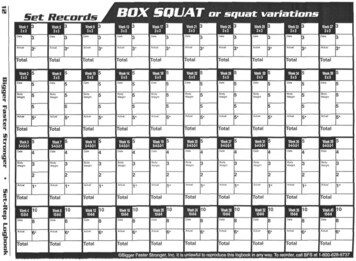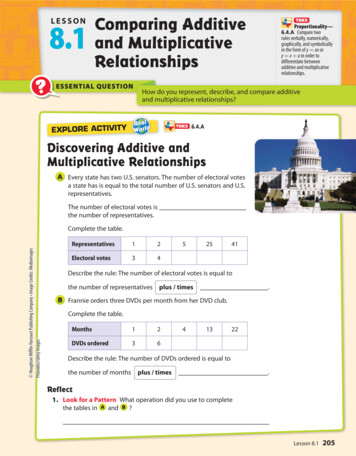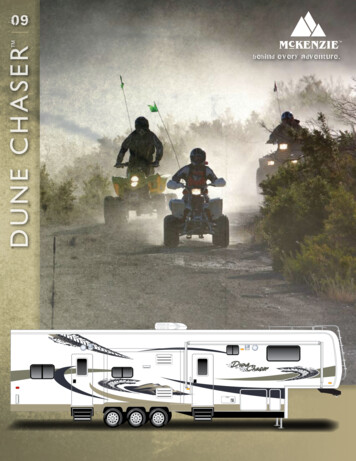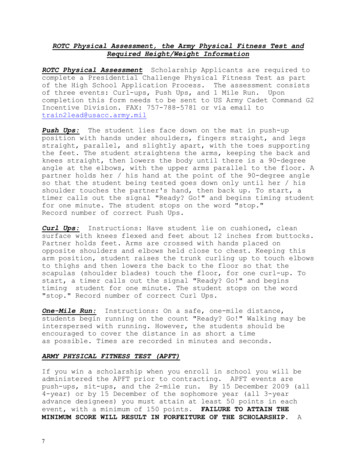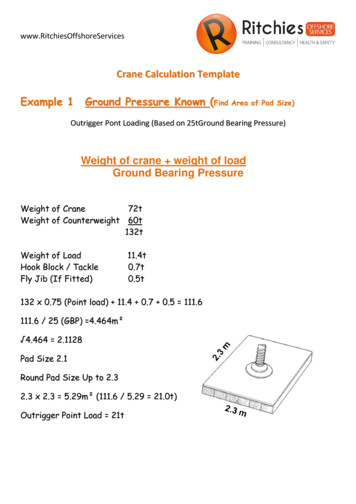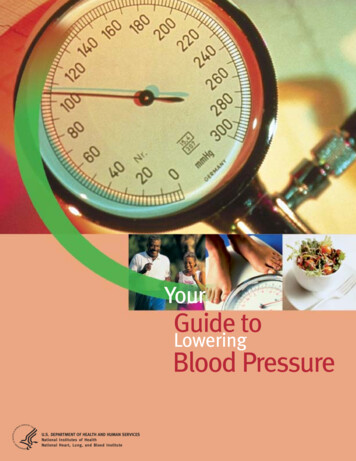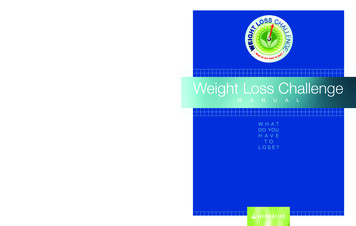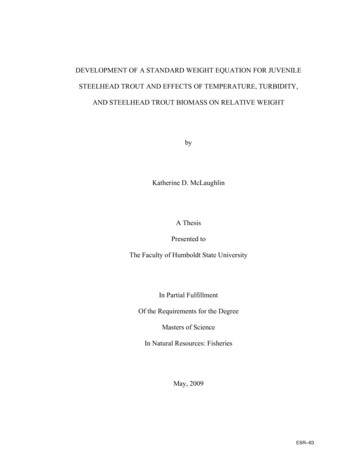
Transcription
DEVELOPMENT OF A STANDARD WEIGHT EQUATION FOR JUVENILESTEELHEAD TROUT AND EFFECTS OF TEMPERATURE, TURBIDITY,AND STEELHEAD TROUT BIOMASS ON RELATIVE WEIGHTbyKatherine D. McLaughlinA ThesisPresented toThe Faculty of Humboldt State UniversityIn Partial FulfillmentOf the Requirements for the DegreeMasters of ScienceIn Natural Resources: FisheriesMay, 2009ESR--63
ESR--63
ABSTRACTDevelopment of a Standard Weight Equation for Juvenile Steelhead Troutand Effects of Temperature, Turbidity, and Steelhead Trout Biomass on Relative WeightKatherine D. McLaughlinStandard weight equations were developed for juvenile steelhead using theregression line percentile and empirical methods. The equation developed using theempirical method better represented juvenile steelhead lengths and weights and was freeof length bias. Standard weight was used to estimate average relative weights forjuvenile steelhead trout populations in northern California streams. Population averagesof relative weight, estimated by the empirical equation, were then modeled againstturbidity, temperature, and juvenile steelhead trout density to determine if these variableshad meaningful relationships with condition.Average relative weight measured in the fall was positively related to degree dayaccumulation during late winter and early spring. Turbidity and biomass metrics werenot found to be significantly related to juvenile steelhead condition. Further research isneeded to determine if relative weight accurately represents the effects of physiological,population and environmental variables on juvenile steelhead condition.iiiESR--63
ACKNOWLEDGEMENTSData used in the analysis for this study were provided by numerous agencies. Iam grateful for the generosity with which individuals at those agencies gave their timeand assistance, though not all of the data shared were used in this study. Steelhead lengthand weight data were from: California Department of Fish and Game-AnadromousFisheries Resource Assessment and Monitoring Program, Green Diamond ResourceCompany, Marin Municipal Water District, Mendocino Redwoods Company, SalmonPopulation and Analysis Team at NOAA Fisheries- Southwest Fisheries Science CenterSanta Cruz Laboratory, Oregon Department of Fish and Wildlife, the Pacific StatesMarine Fisheries Commission, Point Reyes National Seashore, Redwood National andState Parks, Sonoma County Water Agency, U.S. Forest Service, U.S. Geological SurveyCalifornia Cooperative Fish Research Unit ,and the Washington Department of Fish andWildlife.Turbidity and temperature data were obtained from: California State Parks, theCampbell Group LLC, Green Diamond Resource Company, the Mendocino Land Trust,Napa Resource Conservation District, Randy Klein, the U.S. Forest Service PacificSouthwest Research Station, Redwood Science Laboratory, and the U.S. GeologicalSurvey.Access to field sites was generously provided by: the Angelo Coast RangeReserve, Cal FIRE Jackson Demonstration Forest, Campbell Group LLC, GreenDiamond Resources Company, Lee Hudson with Hudson Vineyards, HumboldtivESR--63
vRedwoods State Park, and Redwood National Park. Thanks also to the people who tookthe time to introduce me to the sites.Ken Gerow gave me many hours of guidance on the empirical standard weightmethod, and allowed me to test his automated empirical program in my analysis, forwhich I am very grateful.Much needed statistical, analytical, and logistical assistance came from DavidHankin, Eric Bjorkstedt, Katrina Wright, Jack Lewis, Randy Klein, Deb Visser, LindaMcLaughlin, Phil Colombano, Kristin Mull, Kasey Bleisner, Chad DeYoung, JoelOwens, Kevin Pope, Brian Murphy, and Debby Lehman; thanks to all of you. Thanks toKay Brisby for her patient guidance during my time at Humboldt.I would like to thank the members of my thesis committee, Walt Duffy, BretHarvey, Andrew Kinziger, and Peggy Wilzbach, for guiding me through the researchprocess. Support for this project was provided by the CDFG Fisheries Restoration GrantsProgram.ESR--63
TABLE OF CONTENTSPageABSTRACT .iiiACKNOWLEDGEMENTS .ivLIST OF TABLES . .viiLIST OF FIGURES .viiiLIST OF APPENDICES. .ixINTRODUCTION .1METHODS . .9Development of the Standard Weight Equations . .9Modeled Data .14RESULTS 25Standard Weight Equations .25Biomass and Relative Weight Values .31Turbidity and Temperature .33Models .35DISCUSSION .40LITERATURE CITED 49PERSONAL COMMUNICATIONS .58viESR--63
LIST OF TABLESTable1PageComparison of condition indices. W stands for weight and Lrepresents length for the fish in question .3Steps for selecting length-weight data from juvenile steelheadpopulations for inclusion in the developmental dataset forstandard weight equations .113Description of study sites 164Turbidity and temperature gauge types, sampling intervals,operating agencies, and percent of turbidity data that was estimatedfor each site . . .21Characteristics of juvenile steelhead populations, and temperatureand turbidity data from Northern California streams. Turbidity andtemperature values summarize data from February 11 – April 18of each year, prior to fall fish sampling. Relative weight (Wr) valuesare the average for all juvenile steelhead between 70 – 200 mmcalculated using the empirical method . 34256Estimated coefficients for models in the backwards elimination procedurefor models containing the percentage of time over 30 NephelometricTurbidity Units (NTU) variable (n 15). Response variable is averagerelative weight estimated using the empirical method for juvenilesteelhead trout between 70 – 200 mm. Temperature expressed as degreedays over February 11 – April 18 .377Estimated coefficients for models in the backwards eliminationprocedure for models containing the cumulative turbidity variable(n 15). Response variable is average relative weight for a siteestimated using the empirical method for juvenile steelhead between70 – 200 mm. Temperature expressed as degree days 38Comparison of weights (W) and relative weights (Wr) from differentelectrical balances for a subsample of fish from Bull Creek 2006.Wr values were estimated using the empirical standard weightequation for juvenile steelhead . .468viiESR--63
LIST OF FIGURESFigure1234567PageVariance of log10-transformed weights vs. length for all juvenilesteelhead length-weight pairs considered for the standard weightequation developmental dataset. 26Comparison of relative margin of error plots for the 50-200 mm(dashed line) and 70-200 mm (solid line) empirical standardweight equations for juvenile steelhead .28Intercept coefficients vs. slope coefficients of log10 transformedweight versus length from juvenile steelhead populations in thedevelopmental dataset. Eight populations identified as statisticaloutliers are circled. Data from these populations were includedin the developmental dataset as no transcription or measurementerrors could be detected. .29Standardized residuals versus fork length for the regression linepercentile (top panel) and empirical (bottom panel) standard weightequations for juvenile steelhead 30Relative weight values estimated using the regression linepercentile and empirical techniques plotted against fork length (mm)for juvenile steelhead. Weights representing empirical relativeweights of 100 are indicated by the dotted line; the equivalentregression line percentile relative weights are indicated by theclosed circles .32Plot of all combinations of independent variables (n 15). Two sites(Bull Creek and Elder Creek) were sampled in 2005 and 2006 andtreated as independent samples. Note the high correlation betweenthe Cumulative Turbidity and Percentage Over 30 NTU variables.36Average relative weight versus temperature across study sites (n 15). Regression line represents the model estimated using backwardselimination analysis. The model was based on temperature rangingfrom 532 – 785 degree days from temperature readings from 2.2 to16.1º C .39viiiESR--63
LIST OF APPENDICESAppendixAPageInformation on populations of juvenile steelhead in thedevelopmental dataset, including agency that contributeddata, location, sample size, and regression parameters andcorrelation (R2) of log10 transformed weight and length.Average relative weight (Wr) was estimated using theempirical standard weight equation . .59ixESR--63
INTRODUCTIONIncreased size and weight in juvenile salmonids have repeatedly been linked toincreased overwinter survival (Holtby 1988, Quinn and Peterson 1996) and highersurvival and return rates for smolts (Ward and Slaney 1988, Ward et al. 1989, Tipping1997). Conversely, small fish with lower lipid levels have been shown to have highermortality rates than larger fish with higher lipid content (Biro et al. 2004).Condition is a measure of fish size that may be useful in determining the successof a salmonid. It is thought that condition represents the physiological (Murphy et al.1990) or nutritional (Busacker et al. 1990) state of a fish. Condition, as a measure of theplumpness of a fish, may indicate the quality of environmental conditions includinghabitat and prey availability (Blackwell et al. 2000). Condition indices have the potentialto monitor fish health for large numbers of fish since they are non-lethal and inexpensivemetrics based on length and weight (Fechhelm et al. 1995).If the assumptions of these indices are not met, the resulting estimated conditionwill be erroneous. For example, one assumption of the relative condition factor is thatlength-weight relationships among populations being compared will have equal slopes. Ifthis assumption is not met, the estimated condition will be a factor of length rather thanthe nutritional state of the fish (Bolger and Connolly 1989, Cone 1989). Despite thispotential for misuse, condition indices continue to be used in management and areprevalent in the literature. Condition has been used to describe patterns in fish health,body composition, growth, prey availability, community indices (including density), andfor evaluating management decisions (Blackwell et al. 2000).1ESR--63
2Blackwell et al. (2000) and Froese (2006) reviewed a number of availablecondition indices and determined that not all condition factors are equally useful inmonitoring (Table 1). Fulton’s condition factor (K) assumes isometric growth, which israrely true (Froese 2006). Use of relative condition factor (Kn) requires differentequations for different regions, making comparisons among populations difficult(Carlander 1969). Relative condition factors may only be compared among populationswith similar slopes in length-weight relationships (Bolger and Connolly 1989, Cone1989).The relative weight (Wr) index was developed in an attempt to address theselimitations. Relative weight has been used to compare condition among fish that aredifferent sizes or species (Ney, 1993). Increases in relative weight could imply improvedenvironmental conditions (Murphy et al. 1990, Hubert et al. 1994) or food supply(Flickinger and Bulow 1993, Liao et al. 1995), an increase in growth (Willis 1989,Gabelhouse 1991, Guy and Willis 1995) or overwinter survival (Brown and Murphy1991). Increased relative weight has also been linked to a decrease in fish density(Johnson et al. 1992). It can be used to estimate seasonal changes in condition related tofeeding (Fechhelm 1995) or spawning season (Neumann and Murphy 1992). Therelationship between relative weight and length increment has been shown to changeseasonally and relative weight may better represent growth at certain times of year(Gabelhouse 1991).Given relative weight’s potential relationships with environmental variables, itcould be useful in determining which parameters impact salmonid condition during theirESR--63
3Table 1. Comparison of condition indices. W stands for weight and L represents lengthfor the fish in question.ConditionIndexFulton’sconditionfactor (K)FormulaK 100WL3Properties Assumes isometricgrowth Varies with sex, seasonand degree of gonaddevelopment Used to compare theweight of an individualto that of an idealspecimenWeaknesses Isometric growth rarelytrue (Froese 2006) Compensates for Assumes the lengthchanges in form withweight relationshipchanges in lengthremains constant over theperiod of study Compares weight of thefish in question to an Cannot be used toaverage weight for thatcompare differentlength (allows forpopulations (Carlandercomparison of fish that1969)are different lengths)Relativeconditionfactor (Kn)WaLba intercept,b slopeRelativeweight (Wr)W, Allows for comparison Choice of 75th percentileWSof condition across fishas the standard for weightWs is alengths, populationswas arbitrary (Froesestandardandspecies2006)weight Compares weight of the Regression line percentilerepresentingfish in question to amethod involvesthe 75thstandard weight for thatextrapolating beyondpercentile oflength(allowsformeasured lengths forweight for thecomparison of fish thatpopulation regressionslength inaredifferentlengths)(Murphy et al. 1990)questionKn Wr 100 *ESR--63
4freshwater life history stage. This could potentially show which physical characteristicsin freshwater have the greatest effect on salmonid overwinter, smolting, and survivalsuccess given the link between these factors and size. Using relative weight, populationsare compared to a benchmark, the standard weight. By using the same standard for anentire species, habitat quality impacts can be estimated and compared throughout thespecies’ range.The life history and distribution of steelhead trout make them an appropriatespecies for use in determining the relationship between salmonid condition and habitatquality of coastal streams. Steelhead trout are an ideal candidate for this project becausethey spend from 1 to 3 years in freshwater (Moyle, 2002), so the condition of juvenileswould likely reflect productivity and habitat quality of the freshwater habitat (Duffy et al.2003).There has been a call for further research on impacts of habitat restoration,including road removal (Switalski et al. 2004), on stream-dwelling salmonids. Roadremoval can influence turbidity levels in aquatic ecosystems. Increased road density andthe number of road crossings in a watershed have also been shown to be linked to anincrease in water temperature (expressed as maximum weekly average temperature,Nelitz et al. 2007), making temperature another variable that could be affected by habitatrestorations. Turbidity and temperature are therefore two physical variables that varythroughout stream systems and should be studied further to determine their impact oncondition of salmonids.ESR--63
5Turbidity, which is caused when suspended or dissolved material causes light toscatter or be absorbed (American Public Health Association et al. 1992), has been shownto have an effect on fish growth and size. Numerous studies have reported a decrease ingrowth of fish at higher turbidities or sediment concentrations (Herbert and Richards1963, Sykora et al. 1972, Craig and Babaluk 1989, Sweka and Hartman 2001a).Increasing turbidity has also been reported to result in a decrease in feeding efficiency(Sigler et al. 1984) or to decrease reactive distance in fish (Berg and Northcote 1985,Barrett et al. 1992, Sweka and Hartman 2001b). In addition, turbidity has been shown todecrease primary and secondary production (Lloyd et al. 1987). Both the concentrationof suspended sediment and duration of exposure have been found to influence themagnitude of effect on aquatic organisms. The severity of ill effects of sediment onaquatic organisms increases with increasing duration of exposure (Newcombe andMacDonald 1991, Newcombe and Jensen 1996). In one study, rainbow trout growthdecreased with increasing duration of a constant concentration of sediment exposure(Shaw and Richardson 2001).Water temperature has also been documented to affect growth and size ofsteelhead trout and other salmonids through effects on metabolism, behavior andmortality (Bjornn and Reiser 1991). In a multiyear observational study of salmon andtrout, researchers detected an increase in fish size with an increase of water temperatureexpressed as degree days (up to 2390 degree days for a period of December toSeptember) in a Scottish stream (Egglishaw and Shackley 1977). Age-0 steelhead troutfed to satiation exhibited increased growth rates at increased temperatures (up to 19º C)ESR--63
6in a laboratory setting (Myrick and Cech 2005). Increased fall-spring temperatures(maximum temperature was approximately 11º C) were also shown to result in increasedsimulated growth in rainbow trout (Railsback and Rose 1999). However at extremeupper temperatures, growth may be reduced (Bjornn and Reiser 1991). Neiltz et al.(2007) estimated that juvenile rainbow trout growth would increase with increasingmaximum weekly average temperature until 17º C, after which growth rates declined.Density of fish within a stream is a population parameter that has been linked tofish size or weight. Steelhead trout and other salmonids have had lower weights andsizes (Egglishaw and Shackley 1977, Wentworth and LaBar 1984, Hume and Parkinson1987, Keeley 2003) or decreased growth (Keeley 2001, Harvey et al. 2005) with higherfish densities. However, condition of fish does not appear to vary consistently with fishdensity. Condition has been reported to increase with decreased density and lesscompetition for food (Baccante and Reid 1988). Similarly, a decrease in condition wasobserved with an increase in biomass due to limited prey resources (Verdiell-Cubedo etal. 2006). However, in the laboratory Winfree et al. (1998) found the lowest steelheadtrout condition coinciding with low fish densities. In a review of numerous larval andjuvenile studies, Cowan et al. (2000) concluded that the density-dependent regulation ofgrowth and biomass most likely occurs in the late-larval or juvenile stage of fish, makingthis an appropriate life stage to study when looking at density dependent effects.Given the documented benefits of increased size and the effects of turbidity,temperature, and density on fish size and growth, this study investigated the effects ofthese variables on the condition of juvenile steelhead trout (Oncorhynchus mykiss).ESR--63
7There are currently two methods to estimate relative weight: regression linepercentile (Murphy et al. 1990) and empirical (Gerow et al. 2005). Both procedures uselengths and weights throughout the range of a species to derive a standard weightequation. Relative weight is derived from standard weight using the formula in Table 1.In both the regression line percentile and empirical methods for relative weight,the standard weight is a representation of the 75th percentile of weight from populationsin the developmental dataset. In their earlier relative weight methodology, Wege andAnderson (1978) used 75th percentile weights to calculate the standard weight becausethis value resulted in relative weights approaching 100 for “suitable values” of weight.Murphy et al. (1990) continued the use of 75th percentile weights in their development ofthe regression line percentile method in order to compare their results to those of Wegeand Anderson and also to set a management goal of producing populations with “betterthan-average” condition. However Murphy et al. (1990) warned that the standard ismerely a benchmark and should not represent a universal management target.The difference between the regression line percentile and empirical methods arein the statistical populations modeled to estimate the standard weight equation. In theregression line percentile method, log10 transformed weight is regressed on log10transformed length for each population in the developmental dataset. The parameters ofthese regressions are then used to generate modeled weights which are used to developthe standard weight equation (Murphy et al. 1990). In the empirical method, themeasured lengths and weights from the developmental dataset are used to generate thestandard weight equation (Gerow et al. 2005). Both methods were used in this study toESR--63
8develop standard weight equations and the estimated equations were compared todetermine which was free from length bias and whether there were differences in therelative weights estimated by the two methods.One limitation of the standard weight method comes from extrapolating beyondthe measured lengths used in the creation of the standard weight equation (Blackwell etal. 2000). In addition, the relationship between length and weight often changes asindividuals undergo developmental changes (Tesch 1968). The equation developed inmy study can be used for juvenile fish but would not be applicable to steelhead troutundergoing smoltification since anadromous species undergo a morphological changeduring smolting (Hoar 1976).I used juvenile steelhead trout biomass as an estimate of density. Steelhead troutbiomass as opposed to salmonid biomass was the chosen metric because steelhead trouthave been shown to outcompete (Moyle 2002) or occupy different microhabitats thanother salmonid species (Bisson et al. 1988).The objectives of my study were to develop a standard weight equation forjuvenile steelhead trout using the regression line percentile and empirical techniques,compare the equations to determine if there were differences in relative weightsestimated, and to estimate the effects of turbidity, temperature and density of fish onrelative weight. I estimated average relative weights for populations of juvenile steelheadtrout from streams in northern California. Relative weights were modeled againstturbidity, temperature, and steelhead trout density to determine if condition of steelheadtrout in freshwater systems is related to these physical and population variables.ESR--63
METHODSDevelopment of the Standard Weight EquationsTo derive the standard weight equations, a dataset of juvenile steelhead trout forklength and weight data was compiled. Although differences in condition may occurthroughout the geographic range of steelhead trout, it was necessary for a species-wideequation to be made to allow for comparisons between populations (Murphy et al. 1990).In North America, steelhead trout inhabit coastal streams extending from Alaska to SanMateo Creek, in San Diego County, California (Moyle, 2002). The datasets compiledrepresented samples of steelhead trout populations from Juneau, Alaska to San LuisObispo, California. Length-weight datasets were gathered from a variety of sources,including federal, state, and municipal agencies, timber companies, and universities(Appendix A).Agencies sharing data were asked to confirm that lengths and weights wereobtained from wild, juvenile (pre-smolt) steelhead trout. Data from hatcheries, andmarked hatchery fish (e.g. with fin clips), were not included in the developmental datasetbecause their condition may represent hatchery feeding schedules rather thanenvironmental variation. Lengths and weights from fish known to be smolts wereexcluded because smolts undergo morphological changes before outmigration and theirbody shape form differs from pre-smolts (Hoar 1976). While it is possible that lengthweight data from some hatchery fish or smolts were included in the developmentaldataset, efforts were taken to exclude data known to be from these groups.9ESR--63
10Populations considered for the developmental dataset were assessed to ensuremore than one year of data from a site, outlier length-weight pairs and populations, smalldatasets, and populations in which length was poorly correlated with weight wereexcluded (Table 2). One hundred populations were included in the developmental dataset.The upper and lower lengths used in the standard weight equation weredetermined by plotting the variance of weights against fish length (Flammang et al.1999). If there was a sudden increase in variance of weight when plotted against lengthin 5-mm intervals, that interval was designated to be outside the length range to which thestandard weight equation can be applied.Biological factors also need to be considered in determining the length range for ajuvenile steelhead trout standard weight equation. The lower cutoff needs to considerthat the geographic range for juvenile steelhead trout overlaps with that of cutthroat trout.At lengths less than 70 mm, it is difficult to distinguish between the two species.Additionally, large fish may represent resident rainbow trout rather than anadromoussteelhead trout. These biological factors were considered in conjunction withFlammang’s technique to determine the length range for the standard weight equations.Standard weight equations were developed using the regression line percentile(Murphy et al. 1990) and empirical (Gerow et al. 2005) techniques. Both the regressionline percentile and empirical equations were developed using the same developmentaldatasets over the same length range.The regression line percentile technique treats the log10 transformed weight-lengthregressions for each population as the statistical population to be modeled. TheseESR--63
11Table 2. Steps for selecting length-weight data from juvenile steelhead trout populationsfor inclusion in the developmental dataset for standard weight equations.StepDescriptionCheck speciesand units ofmeasure.Remove length-weight information on non-steelhead trout species and known smolts orhatchery-raised fish. Check that fork lengths and weight were recorded in metric units.Separate data bystream and yearDelete lengthweight pairoutliersDeterminelength range forthe equationDeletepopulationswith samplesize 30Deletepopulationswith weightlengthcorrelation 0.90aDeletepopulations thatare outliers bSort into populations representing one year of sampling data for each stream. Forstreams with multiple years of data, the year with the most length-weight pairs was thepopulation used in the developmental dataset (Pope et al. 1995).Examine populations for outliers in the length-weight data points, which may haveresulted from measuring or transcription error. Errors were identified by plotting log10weight against log10 length and deleting obvious outliers (Bister et al. 2000).Plot the variance of weights against fish length (Flammang et al. 1999). If there is asudden increase in variance of weight when plotted against length in 5-mm intervals,that interval was designated outside the length range. Length-weight pairs outside ofthe upper and lower limits for the equation’s length range were eliminated from thedevelopmental dataset.Delete populations with small numbers of length-weight pairs from the developmentaldataset. The literature recommends that populations in the developmental dataset haveat least 10 length-weight pairs (Murphy et al. 1990, Pope et al. 1995), due to the largenumber and sizes of datasets available for juvenile steelhead trout, a minimum of 30fish was used in my study.Screen populations to ensure length is correlated with weight (Brown and Murphy 1996,Bister et al. 2000). The literature recommends a cutoff of 0.80 for the coefficient ofdetermination, R2 (Pope et al. 1995, Flammang et al. 1999). However I deletedpopulations from the developmental dataset if their R2 was less than 0.90. Mydevelopmental dataset was large enough to accommodate a higher minimum correlationcoefficient.Plot the y-intercept as a function of slope for log10 transformed weight-lengthregressions for each population (Pope et al. 1995) and visually inspect for outliers. Abox plot analysis was also conducted to determine which slopes and intercepts wereoutliers (Mendenhall et al. 2005). Any populations with parameters that were outliersfrom the rest of the developmental dataset were further examined (Pope 2006, personalcommunication, Willis 2006, personal communication).aNo populations were deleted from my developmental dataset because of low weight-length correlation.No obvious errors were detected (e.g., transcription errors) in outlier populations in my developmentaldataset. In populations that had slopes or intercepts that were outliers, these values were assumed to beoutliers because of variation from natural differences in condition among the populations. The populationswith slopes or intercepts that were outliers were therefore not excluded from the developmental dataset.bESR--63
12regressions were used to predict log10 weights for the mid-point of each length class.Five mm length classes were used since the range of lengths in an equation for juvenilesis smaller than ranges used for adult fish (Flammang et al. 1999). The modeled log10weights for all regressions in the statistical population were back-transformed to weightto determine the 75th percentile of weights for the midpoint of each length class. Log10transformed 75th percentile weights were regressed against log10 lengths to determine theparameters of the standard weight equation (Murphy et al. 1990).The empirical method uses empirical data, rather than modeled weights, indetermining the 75th percentile of weights (Gerow et al. 2005). Within each population,weights were averaged for each length class and the Blom estimator (Gerow 2009) of thethird quartile of average weights was used to calculate the 75th percentile of the weights.The Blom estimator is a rank estimator used to reduce pos
The Faculty of Humboldt State University In Partial Fulfillment Of the Requirements for the Degree Masters of Science In Natural Resources: Fisheries May, 2009 ESR--63. ESR--63. ABSTRACT Development of a Standard Weight Equation for Juvenile Steelhead Trout . Hankin, Eric Bjorkstedt, Katrina Wright, Jack Lewis, Randy Klein, Deb Visser, Linda
